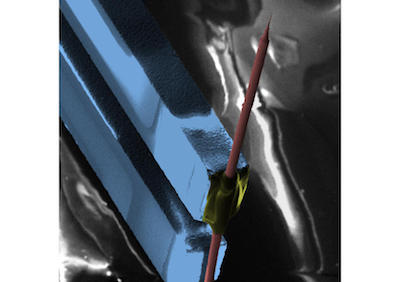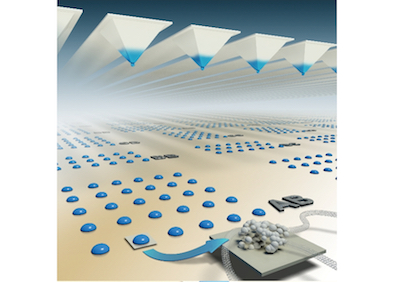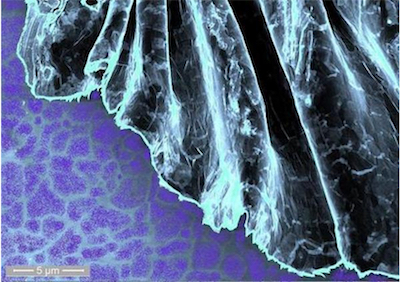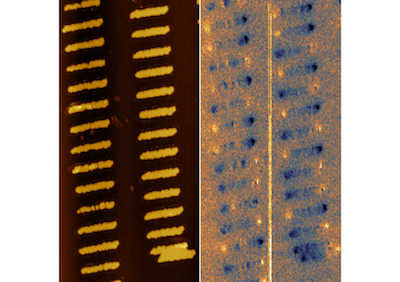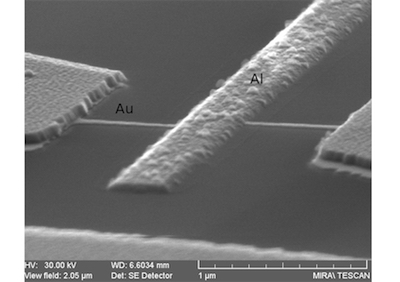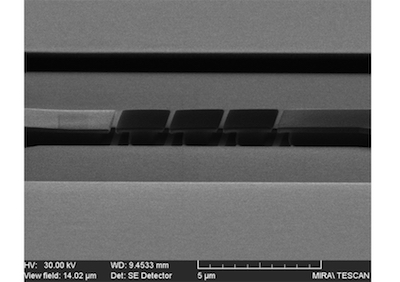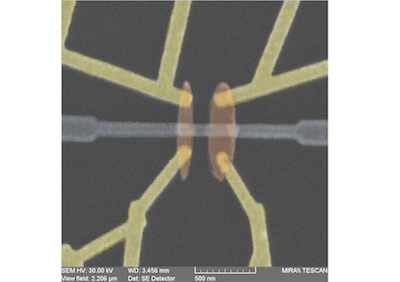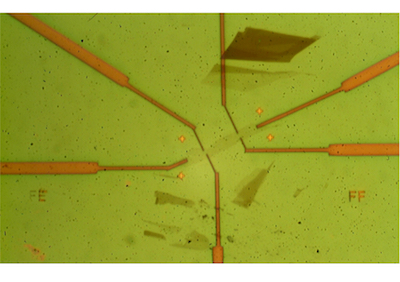Patrick W Krantz; Alexander Tyner; Pallab Goswami; Venkat Chandrasekhar
Intrinsic magnetism in KTaO3 heterostructures Journal Article
In: Applied Physics Letters, vol. 124, pp. 093102, 2024.
Abstract | Links | BibTeX | Tags: Magnetism, perovskite
@article{Krantz2024,
title = {Intrinsic magnetism in KTaO3 heterostructures},
author = {Patrick W Krantz and Alexander Tyner and Pallab Goswami and Venkat Chandrasekhar},
url = {https://pubs.aip.org/aip/apl/article/124/9/093102/3267521/Intrinsic-magnetism-in-KTaO3-heterostructures},
doi = {doi: 10.1063/5.0189956},
year = {2024},
date = {2024-02-27},
urldate = {2024-02-27},
journal = {Applied Physics Letters},
volume = {124},
pages = {093102},
abstract = {There has been intense recent interest in the two-dimensional electron gases (2DEGs) that form at the surfaces and interfaces of KTaO 3
(KTO), with the discovery of superconductivity at temperatures significantly higher than those of similar 2DEGs based on SrTiO 3 (STO).
Like STO heterostructures, these KTO 2DEGs are formed by depositing an overlayer on top of appropriately prepared KTO surfaces. Some
of these overlayers are magnetic, and the resulting 2DEGs show signatures of this magnetism, including hysteresis in the magnetoresistance
(MR). Here, we show that KTO 2DEGs fabricated by depositing AlOx on top of KTO also show hysteretic MR, indicative of long-range mag-
netic order, even though the samples nominally contain no intrinsic magnetic elements. The hysteresis appears in both the transverse and
longitudinal resistance in magnetic fields both perpendicular to and in the plane of the 2DEG. The hysteretic MR has different characteristic
fields and shapes for surfaces of different crystal orientations and vanishes above a few Kelvin. Density functional theory (DFT) calculations
indicate that the magnetism likely arises from Ta 4+ local moments created in the presence of oxygen vacancies.},
keywords = {Magnetism, perovskite},
pubstate = {published},
tppubtype = {article}
}
(KTO), with the discovery of superconductivity at temperatures significantly higher than those of similar 2DEGs based on SrTiO 3 (STO).
Like STO heterostructures, these KTO 2DEGs are formed by depositing an overlayer on top of appropriately prepared KTO surfaces. Some
of these overlayers are magnetic, and the resulting 2DEGs show signatures of this magnetism, including hysteresis in the magnetoresistance
(MR). Here, we show that KTO 2DEGs fabricated by depositing AlOx on top of KTO also show hysteretic MR, indicative of long-range mag-
netic order, even though the samples nominally contain no intrinsic magnetic elements. The hysteresis appears in both the transverse and
longitudinal resistance in magnetic fields both perpendicular to and in the plane of the 2DEG. The hysteretic MR has different characteristic
fields and shapes for surfaces of different crystal orientations and vanishes above a few Kelvin. Density functional theory (DFT) calculations
indicate that the magnetism likely arises from Ta 4+ local moments created in the presence of oxygen vacancies.
Patrick W Krantz; Venkat Chandrasekhar
Nonlocal Differential Resistance in AlOx/KTaO3 Heterostructures Journal Article
In: 2022.
Abstract | Links | BibTeX | Tags: Magnetism, Mesoscopic quantum transport, perovskite, spin-orbit scattering
@article{Krantz2022,
title = {Nonlocal Differential Resistance in AlOx/KTaO3 Heterostructures},
author = {Patrick W Krantz and Venkat Chandrasekhar},
url = {https://arxiv.org/abs/2210.12146},
year = {2022},
date = {2022-10-22},
abstract = {Local and nonlocal differential resistance measurements on Hall bars defined in AlOx/KTaO3 heterostructures show anomalous behavior that depends on the crystal orientation and the applied back gate voltage. The local differential resistance is asymmetric in the dc bias current, with an antisymmetric component that grows with decreasing gate voltage. More surprisingly, a large nonlocal differential resistance is observed that extends between measurement probes that are separated by 100s of microns. The potential source of this anomalous behavior is discussed.},
keywords = {Magnetism, Mesoscopic quantum transport, perovskite, spin-orbit scattering},
pubstate = {published},
tppubtype = {article}
}
Patrick Krantz; Alex Tyner; Pallab Goswami; Venkat Chandrasekhar
Colossal Spontaneous Hall Effect and Emergent Magnetism in KTaO3 Two-Dimensional Electron Gases Journal Article
In: 2022.
Abstract | Links | BibTeX | Tags: AMR, magnetic impurity, Magnetism, perovskite, Superconductivity
@article{nokey,
title = {Colossal Spontaneous Hall Effect and Emergent Magnetism in KTaO3 Two-Dimensional Electron Gases},
author = {Patrick Krantz and Alex Tyner and Pallab Goswami and Venkat Chandrasekhar},
url = {https://arxiv.org/abs/2209.10534},
year = {2022},
date = {2022-09-21},
urldate = {2022-09-21},
abstract = {There has been intense recent interest in the two-dimensional electron gases (2DEGs) that form at the surfaces and interfaces of KTaO$_3$ (KTO), with the discovery of superconductivity at temperatures significantly higher than those of similar 2DEGs based on SrTiO$_3$ (STO). Here we demonstrate that KTO 2DEGs fabricated under conditions that suppress the superconductivity show a large spontaneous Hall effect at low temperatures. The transverse response is asymmetric in an applied perpendicular magnetic field and becomes hysteretic at millikelvin temperatures. The hysteresis is due to long range magnetic order arising from local Ta$^{4+}$ moments. However, the most striking features of the data are the asymmetry of the transverse response and the large spontaneous transverse resistance at zero field, which can be a significant fraction of the longitudinal resistance and depends on crystal orientation. Both effects are due to the presence of a dominant contribution to the transverse response that is symmetric in perpendicular field, suggesting that its origin is topological in nature. We argue that this contribution arises from Berry curvature dipoles coupled with nonequilibrium conditions induced by the measuring current.},
keywords = {AMR, magnetic impurity, Magnetism, perovskite, Superconductivity},
pubstate = {published},
tppubtype = {article}
}
Taewan Noh
Nonlocal correlations in a proximity-coupled normal metal PhD Thesis
Northwestern University, 2019.
Abstract | Links | BibTeX | Tags: Andreev reflection, Magnetism, Proximity effect, Superconductivity
@phdthesis{Noh2019,
title = {Nonlocal correlations in a proximity-coupled normal metal},
author = {Taewan Noh},
url = {http://www.nano.northwestern.edu/wp-content/uploads/2024/11/Thesis_Taewan_Noh.pdf},
year = {2019},
date = {2019-12-01},
urldate = {2019-12-01},
address = {2145 Sheridan Road, Evanston, IL 60208},
school = {Northwestern University},
abstract = {A superconductor-normal metal-superconductor (SNS) junction is capable of carrying supercurrent due to the Josephson coupling between the two superconductors. More inter- estingly, this coupling is maintained through the normal metal in a length determined by the Thouless energy of the normal metal, which can be a few microns, much longer than the case of conventional Josephson junction consisting of two superconductors separated by a thin insulator, where the thickness is only a few nanometers. This provides us with a capability of measuring the electric potential in the proximity-coupled normal metal by placing multiple probes on it. In particular, in this thesis we present the experimental results of our attempt to search nonlocal correlations mediated by a proximity-coupled normal metal via electrical transport measurements. At very low temperatures, with an overall dependence on the bias current seemingly analogous to that observed in prior experiments on NSN structures, the nonlocal differential resistance exhibits a peculiar dip in a small range of bias current. In addition to the qualitative explanation that accounts for the nonlocal differential resistance arising from the separation of quasiparticle current due to the Josephson coupling between the two superconductors, further analysis based on the quasiclassical theory of superconduc- tivity reveals that the central dip can be attributed to penetration of pair correlations into the proximity-coupled normal metal from both superconductors in a coherent manner. While the processes analogous to crossed Andreev reflection and elastic cotunneling observed in a superconductor are yet to be found, our data and analysis provide insights on the physics behind the interplay between the quasiparticle current and the supercurrent which gives rise to the observed nonlocal correlations in a proximity-coupled normal metal.
Beside the nonlocal correlations in a proximity-coupled normal metal, we also investigated electrical transport through a heterostructure including double superconductor-ferromagnet (FS) interfaces. In addition to a typical signature of spin imbalance due to the Zeeman splitting in the density of states (DOS) of the quasiparticles in a superconductor, an inter- esting feature in a small range of bias current has been observed, which might be related to spin-dependent phenomena at FS interfaces although further investigation in a simpler geometry of the sample is required to elucidate the exact mechanism.},
keywords = {Andreev reflection, Magnetism, Proximity effect, Superconductivity},
pubstate = {published},
tppubtype = {phdthesis}
}
Beside the nonlocal correlations in a proximity-coupled normal metal, we also investigated electrical transport through a heterostructure including double superconductor-ferromagnet (FS) interfaces. In addition to a typical signature of spin imbalance due to the Zeeman splitting in the density of states (DOS) of the quasiparticles in a superconductor, an inter- esting feature in a small range of bias current has been observed, which might be related to spin-dependent phenomena at FS interfaces although further investigation in a simpler geometry of the sample is required to elucidate the exact mechanism.
V. V. Bal; Z. Huang; K. Han; Ariando; T. Venkatesan; V. Chandrasekhar
Low temperature magnetoresistance of (111) (La0.3Sr0.7)(Al0.65Ta0.35)/SrTiO3 Journal Article
In: Physical Review B, vol. 99, pp. 035408, 2019.
Abstract | Links | BibTeX | Tags: epitaxial, magnetic impurity, Magnetism, perovskite, phase coherence, spin glass, Superconductivity
@article{Bal2018,
title = {Low temperature magnetoresistance of (111) (La0.3Sr0.7)(Al0.65Ta0.35)/SrTiO3},
author = {V. V. Bal and Z. Huang and K. Han and Ariando and T. Venkatesan and V. Chandrasekhar},
url = {https://journals.aps.org/prb/abstract/10.1103/PhysRevB.99.035408},
doi = {https://doi.org/10.1103/PhysRevB.99.035408},
year = {2019},
date = {2019-01-03},
journal = {Physical Review B},
volume = {99},
pages = {035408},
abstract = {The two-dimensional conducting interfaces in SrTiO3-based systems are known to show a variety of coexisting and competing phenomena in a complex phase space. Magnetoresistance measurements, which are typically used to extract information about the various interactions in these systems, must be interpreted with care, since multiple interactions can contribute to the resistivity in a given range of magnetic field and temperature. Here we review all the phenomena that can contribute to transport in SrTiO3-based conducting interfaces at low temperatures. We apply this understanding to the perpendicular magnetoresistance data of the high-mobility system of (111) oriented (La0.3Sr0.7)(Al0.65Ta0.35)O3/STO heterostructures, and find an excess negative magnetoresistance contribution which cannot be explained by weak localization alone. We argue that contributions from magnetic scattering as well as electron-electron interactions, combined with weak localization/antilocalization, can provide a possible explanation for the observed magnetoresistance.},
keywords = {epitaxial, magnetic impurity, Magnetism, perovskite, phase coherence, spin glass, Superconductivity},
pubstate = {published},
tppubtype = {article}
}
Varada Vilas Bal
Transport Measurements on (111) Oriented (La0.3Sr0.7)(Al0.65Ta0.35)O3/SrTiO3 Heterostructures PhD Thesis
Northwestern University, 2018.
Abstract | Links | BibTeX | Tags: epitaxial, Kondo effect, magnetic impurity, Magnetism, perovskite, spin-orbit scattering, Superconductivity, superconductor
@phdthesis{Bal2018b,
title = {Transport Measurements on (111) Oriented (La0.3Sr0.7)(Al0.65Ta0.35)O3/SrTiO3 Heterostructures},
author = {Varada Vilas Bal},
url = {http://www.nano.northwestern.edu/wp-content/uploads/2018/09/BalVarada_PhD_Thesis.pdf},
year = {2018},
date = {2018-09-01},
address = {Department of Physics},
school = {Northwestern University},
abstract = {At the interface of two dissimilar entities, something novel can emerge. This idea has driven a vast amount of fruitful work on semiconductor interfaces, and given us the digi- tal revolution. In the past decade, remarkable progress has been made in the synthesis and understanding of interfaces between oxides, opening up new avenues to explore fundamen- tal emergent physics at the interface, as well as to provide viable candidates to augment or even surpass the performance of conventional semiconductor electronics. The two- dimensional conducting interface in the (001) LaAlO3/SrTiO3 system is the most studied example of oxide interfaces, showing a wide range of coexisting and competing phenomena such as superconductivity, superconductor-insulator transitions, magnetism, and spin- orbit interactions. The (111) oriented LaAlO3/SrTiO3 system has been recently found to have a few surprises of its own, with intriguing anisotropies in many transport properties along different in-plane crystal directions. This thesis presents the first results on a different SrTiO3 based system: the conducting interface between (La0.3Sr0.7)(Al0.65Ta0.35) and (111) oriented SrTiO3, which has a smaller strain as compared to the LaAlO3/SrTiO3 system. Electrical transport measurements at cryogenic temperatures reveal that no systematic anisotropy is seen in transport properties, unlike in the case of (111) oriented LaAlO3/SrTiO3. High-field magnetotransport shows the presence of high-mobility carri- ers at high electron densities, and exhibits multiband behavior, tunable in situ using an electrical back-gate, similar to the LaAlO3/SrTiO3 system. The data allow us to draw specific conclusions about band ordering in the system, and point to possible differences between the band ordering in (111) (La0.3Sr0.7)(Al0.65Ta0.35)O3/SrTiO3 and (001) as well as (111) oriented LaAlO3/SrTiO3. Low-field magnetotransport reveals that a strong spin- orbit interaction emerges in the regime of low electron density, when the high-mobility carriers are depleted from the system, a trend which is opposite to that observed in (001) oriented LaAlO3/SrTiO3. The most striking feature is that at millikelvin temperatures, in the regime of low electron densities, concomitant with the development of strong spin- orbit interaction, magnetic order emerges.},
keywords = {epitaxial, Kondo effect, magnetic impurity, Magnetism, perovskite, spin-orbit scattering, Superconductivity, superconductor},
pubstate = {published},
tppubtype = {phdthesis}
}
V. V. Bal; Z. Huang; K. Han; Ariando; T. Venkatesan; V. Chandrasekhar
Strong spin-orbit coupling and magnetism in (111) (La0.3Sr0.7)(Al0.65Ta0.35)/SrTiO3 Journal Article
In: Physical Review B, vol. 98, pp. 085416, 2018.
Abstract | Links | BibTeX | Tags: epitaxial, Magnetism, perovskite
@article{Bal2017b,
title = {Strong spin-orbit coupling and magnetism in (111) (La0.3Sr0.7)(Al0.65Ta0.35)/SrTiO3},
author = {V. V. Bal and Z. Huang and K. Han and Ariando and T. Venkatesan and V. Chandrasekhar},
url = {https://journals.aps.org/prb/abstract/10.1103/PhysRevB.98.085416},
doi = {https://doi.org/10.1103/PhysRevB.98.085416},
year = {2018},
date = {2018-08-07},
journal = {Physical Review B},
volume = {98},
pages = {085416},
abstract = {Two-dimensional conducting interfaces in SrTiO3-based heterostructures display a variety of coexisting and competing physical phenomena, which can be tuned by the application of a gate voltage. (111) oriented heterostructures have recently gained attention due to the possibility of finding exotic physics in these systems due to their hexagonal surface crystal symmetry. In this work, we use magnetoresistance to study the evolution of spin-orbit interaction and magnetism in (111) oriented (La0.3Sr0.7)(Al0.65Ta0.35)O3/SrTiO3. At more positive values of the gate voltage, which correspond to high carrier densities, we find that transport is multiband, and dominated by high-mobility carriers with a tendency toward weak localization. At more negative gate voltages, the carrier density is reduced, the high-mobility bands are depopulated, and weak antilocalization effects begin to dominate, indicating that spin-orbit interaction becomes stronger. At millikelvin temperatures, at gate voltages corresponding to the strong spin-orbit regime, we observe hysteresis in magnetoresistance, indicative of ferromagnetism in the system. Our results suggest that in the (111) (La0.3Sr0.7)(Al0.65Ta0.35)O3/SrTiO3 system, low-mobility carriers that experience strong spin-orbit interactions participate in creating magnetic order in the system.},
keywords = {epitaxial, Magnetism, perovskite},
pubstate = {published},
tppubtype = {article}
}
Samuel Kenneth Davis
Emergent Phenomena at the (111) LaAlO3/SrTiO3 Interface PhD Thesis
Department of Physics, Northwestern University, 2017.
Abstract | Links | BibTeX | Tags: Magnetism, perovskite, Superconductivity
@phdthesis{Davis2017c,
title = {Emergent Phenomena at the (111) LaAlO3/SrTiO3 Interface},
author = {Samuel Kenneth Davis},
url = {http://www.nano.northwestern.edu/wp-content/uploads/2018/02/Davis-Thesis.pdf},
year = {2017},
date = {2017-12-01},
school = {Department of Physics, Northwestern University},
abstract = {In his Nobel lecture Herbert Kroemer famously stated that “The interface is the device”. While he made this statement in the context of semiconducting heterostructures, it has proven to be just as relevant for more complex materials, such as the transition metal oxides. In particular, the 2-D conducting gas that forms at the interface between two transition metal oxides LaAlO3 and SrTiO3 (LAO/STO) has shown that a system containing a rich phase space of phenomena can arise from the interface of two relatively boring insulators. These phenomena include superconductivity, magnetism, gate tuned metal to insulator and superconductor to insulator transitions as well as evidence of large spin-orbit coupling at the interface. While the observation of these effects has produced more than a decade of fervent research on the LAO/STO interface, these previous efforts have focused mainly on the (001) crystal orientation of the LAO/STO interface. This thesis presents the results of some of the first studies on the (111) orientation of the LAO/STO interface, which not only has a more complex interfacial symmetry, but also shows new emergent phenomena. The most striking of which is the observation of strong, in-plane, anisotropy in the almost all of interface’s electrical transport properties. The thesis will identify not only identify where this anisotropy “lives” in the (111) LAO/STO interface, but also examine the energy scale at which it onsets. These results are evidence of an electronic nematic state that breaks the rotational symmetry of the sample. Finally, it will explore how this anisotropy impacts the other phenomena present at the interface, superconductivity and ferromagnetism.},
keywords = {Magnetism, perovskite, Superconductivity},
pubstate = {published},
tppubtype = {phdthesis}
}
S. Davis; Z. Huang; K. Han; Ariando; T. Venkatesan; V. Chandrasekhar
Magnetoresistance in the superconducting state at the (111) LaAlO3/SrTiO3 interface Journal Article
In: Physical Review B, vol. 96, pp. 134502, 2017.
Abstract | Links | BibTeX | Tags: epitaxial, Magnetism, perovskite, Superconductivity
@article{Davis2017,
title = {Magnetoresistance in the superconducting state at the (111) LaAlO3/SrTiO3 interface},
author = {S. Davis and Z. Huang and K. Han and Ariando and T. Venkatesan and V. Chandrasekhar},
url = {https://journals.aps.org/prb/abstract/10.1103/PhysRevB.96.134502},
doi = {https://doi.org/10.1103/PhysRevB.96.134502},
year = {2017},
date = {2017-07-11},
journal = {Physical Review B},
volume = {96},
pages = {134502},
abstract = {Condensed-matter systems that simultaneously exhibit superconductivity and ferromagnetism are rare due the antagonistic relationship between conventional spin-singlet superconductivity and ferromagnetic order. In materials in which superconductivity and magnetic order are known to coexist (such as some heavy-fermion materials), the superconductivity is thought to be of an unconventional nature. Recently, the conducting gas that lives at the interface between the perovskite band insulators LaAlO3 (LAO) and SrTiO3 (STO) has also been shown to host both superconductivity and magnetism. Most previous research has focused on LAO/STO samples in which the interface is on the (001) crystal plane. Relatively little work has focused on the (111) crystal orientation, which has hexagonal symmetry at the interface, and has been predicted to have potentially interesting topological properties, including unconventional superconducting pairing states. Here we report measurements of the magnetoresistance of (111) LAO/STO heterostructures at temperatures at which they are also superconducting. As with the (001) structures, the magnetoresistance is hysteretic, indicating the coexistence of magnetism and superconductivity, but in addition, we find that this magnetoresistance is anisotropic. Such an anisotropic response is completely unexpected in the superconducting state and suggests that (111) LAO/STO heterostructures may support unconventional superconductivity.},
keywords = {epitaxial, Magnetism, perovskite, Superconductivity},
pubstate = {published},
tppubtype = {article}
}
V.V Bal; Zhen Huang; Kun Han; Ariando; T Venkatesan; Venkat Chandrasekhar
Electrostatic tuning of magnetism at the conducting (111) (La0.3Sr0.7)(Al0.65Ta0.35)/SrTiO3 interface Journal Article
In: Applied Physics Letters, vol. 111, no. 8, pp. 081604, 2017.
Abstract | Links | BibTeX | Tags: epitaxial, Magnetism, perovskite
@article{Bal2017,
title = {Electrostatic tuning of magnetism at the conducting (111) (La0.3Sr0.7)(Al0.65Ta0.35)/SrTiO3 interface},
author = {V.V Bal and Zhen Huang and Kun Han and Ariando and T Venkatesan and Venkat Chandrasekhar},
url = {http://aip.scitation.org/doi/10.1063/1.4986912},
doi = {http://dx.doi.org/10.1063/1.4986912},
year = {2017},
date = {2017-06-06},
journal = {Applied Physics Letters},
volume = {111},
number = {8},
pages = {081604},
abstract = {We present measurements of the low temperature electrical transport properties of the two dimensional carrier gas that forms at the interface of (111) (La0.3Sr0.7)(Al0.65Ta0.35)/SrTiO3 (LSAT/STO) as a function of applied back gate voltage, Vg. As is found in (111) LaAlO3/SrTiO3 interfaces, the low-field Hall coefficient is electron-like, but shows a sharp reduction in magnitude below Vg∼ 20 V, indicating the presence of hole-like carriers in the system. This same value of Vg correlates approximately with the gate voltage below which the magnetoresistance evolves from nonhysteretic to hysteretic behavior at millikelvin temperatures, signaling the onset of magnetic order in the system. We believe our results can provide insight into the mechanism of magnetism in SrTiO3 based systems.},
keywords = {epitaxial, Magnetism, perovskite},
pubstate = {published},
tppubtype = {article}
}
Manan Mehta
Interplay between superconductivity and ferromagnetism at the LaAlO3/SrTiO3 interface PhD Thesis
2015.
Links | BibTeX | Tags: AMR, epitaxial, Kondo effect, Magnetic force microscopy, Magnetism, Mesoscopic quantum transport, scanning probe, Superconductivity, vortex dynamics
@phdthesis{Mehta2015,
title = {Interplay between superconductivity and ferromagnetism at the LaAlO3/SrTiO3 interface},
author = {Manan Mehta},
url = {http://www.nano.northwestern.edu/wp-content/uploads/2017/09/Manan_Mehta_PhD_Thesis.pdf},
year = {2015},
date = {2015-12-01},
keywords = {AMR, epitaxial, Kondo effect, Magnetic force microscopy, Magnetism, Mesoscopic quantum transport, scanning probe, Superconductivity, vortex dynamics},
pubstate = {published},
tppubtype = {phdthesis}
}
V. V. Bal; M. M. Mehta; S. Ryu; H. Lee; C. M. Folkman; C. B. Eom; V. Chandrasekhar
Gate-tunable superconducting weak link behavior in top-gated LaAlO3-SrTiO3 Journal Article
In: Applied Physics Letters, vol. 106, no. 21, pp. 212601, 2015.
Links | BibTeX | Tags: epitaxial, Magnetism, perovskite, Proximity effect, Superconductivity
@article{bal_gate-tunable_2015,
title = {Gate-tunable superconducting weak link behavior in top-gated LaAlO3-SrTiO3},
author = { V. V. Bal and M. M. Mehta and S. Ryu and H. Lee and C. M. Folkman and C. B. Eom and V. Chandrasekhar},
url = {http://scitation.aip.org/content/aip/journal/apl/106/21/10.1063/1.4921924},
year = {2015},
date = {2015-01-01},
urldate = {2016-12-28},
journal = {Applied Physics Letters},
volume = {106},
number = {21},
pages = {212601},
keywords = {epitaxial, Magnetism, perovskite, Proximity effect, Superconductivity},
pubstate = {published},
tppubtype = {article}
}
M. M. Mehta; D. A. Dikin; C. W. Bark; S. Ryu; C. M. Folkman; C. B. Eom; V. Chandrasekhar
Magnetic field tuned superconductor-to-insulator transition at the LaAlO 3 / SrTiO 3 interface Journal Article
In: Physical Review B, vol. 90, no. 10, 2014, ISSN: 1098-0121, 1550-235X.
Links | BibTeX | Tags: epitaxial, insulator, Magnetism, perovskite, superconductor
@article{mehta_magnetic_2014,
title = {Magnetic field tuned superconductor-to-insulator transition at the LaAlO 3 / SrTiO 3 interface},
author = { M. M. Mehta and D. A. Dikin and C. W. Bark and S. Ryu and C. M. Folkman and C. B. Eom and V. Chandrasekhar},
url = {http://link.aps.org/doi/10.1103/PhysRevB.90.100506},
doi = {10.1103/PhysRevB.90.100506},
issn = {1098-0121, 1550-235X},
year = {2014},
date = {2014-01-01},
urldate = {2015-10-23},
journal = {Physical Review B},
volume = {90},
number = {10},
keywords = {epitaxial, insulator, Magnetism, perovskite, superconductor},
pubstate = {published},
tppubtype = {article}
}
M.M. Mehta; D.A. Dikin; C.W. Bark; S. Ryu; C.M. Folkman; C.B. Eom; V. Chandrasekhar
Evidence for charge–vortex duality at the LaAlO3/SrTiO3 interface Journal Article
In: Nature Communications, vol. 3, pp. 955, 2012, ISSN: 2041-1723.
Links | BibTeX | Tags: epitaxial, insulator, Magnetism, perovskite, Superconductivity
@article{mehta_evidence_2012,
title = {Evidence for charge–vortex duality at the LaAlO3/SrTiO3 interface},
author = { M.M. Mehta and D.A. Dikin and C.W. Bark and S. Ryu and C.M. Folkman and C.B. Eom and V. Chandrasekhar},
url = {http://www.nature.com/doifinder/10.1038/ncomms1959},
doi = {10.1038/ncomms1959},
issn = {2041-1723},
year = {2012},
date = {2012-07-01},
urldate = {2015-10-23},
journal = {Nature Communications},
volume = {3},
pages = {955},
keywords = {epitaxial, insulator, Magnetism, perovskite, Superconductivity},
pubstate = {published},
tppubtype = {article}
}
D. A. Dikin; M. Mehta; C. W. Bark; C. M. Folkman; C. B. Eom; V. Chandrasekhar
Coexistence of Superconductivity and Ferromagnetism in Two Dimensions Journal Article
In: Physical Review Letters, vol. 107, no. 5, 2011, ISSN: 0031-9007, 1079-7114.
Links | BibTeX | Tags: epitaxial, Magnetism, perovskite, Superconductivity
@article{dikin_coexistence_2011,
title = {Coexistence of Superconductivity and Ferromagnetism in Two Dimensions},
author = { D. A. Dikin and M. Mehta and C. W. Bark and C. M. Folkman and C. B. Eom and V. Chandrasekhar},
url = {http://link.aps.org/doi/10.1103/PhysRevLett.107.056802},
doi = {10.1103/PhysRevLett.107.056802},
issn = {0031-9007, 1079-7114},
year = {2011},
date = {2011-07-01},
urldate = {2015-10-26},
journal = {Physical Review Letters},
volume = {107},
number = {5},
keywords = {epitaxial, Magnetism, perovskite, Superconductivity},
pubstate = {published},
tppubtype = {article}
}
Goutam Sheet; Alexandra R. Cunliffe; Erik J. Offerman; Chad M. Folkman; Chang-Beom Eom; Venkat Chandrasekhar
dc and high frequency magnetic properties of nanopatterned CoFe2O4 arrays fabricated using sol-gel precursors Journal Article
In: Journal of Applied Physics, vol. 107, no. 10, pp. 104309, 2010, ISSN: 0021-8979, 1089-7550.
Links | BibTeX | Tags: Magnetism, microwave, perovskite, scanning probe
@article{sheet_dc_2010,
title = {dc and high frequency magnetic properties of nanopatterned CoFe2O4 arrays fabricated using sol-gel precursors},
author = { Goutam Sheet and Alexandra R. Cunliffe and Erik J. Offerman and Chad M. Folkman and Chang-Beom Eom and Venkat Chandrasekhar},
url = {http://aip.scitation.org/doi/10.1063/1.3393745},
doi = {10.1063/1.3393745},
issn = {0021-8979, 1089-7550},
year = {2010},
date = {2010-05-01},
urldate = {2016-12-28},
journal = {Journal of Applied Physics},
volume = {107},
number = {10},
pages = {104309},
keywords = {Magnetism, microwave, perovskite, scanning probe},
pubstate = {published},
tppubtype = {article}
}
Alexandra R. Cunliffe
2009.
Links | BibTeX | Tags: AMR, epitaxial, FMR, Magnetic force microscopy, Magnetism, nanomagnets, perovskite, scanning probe
@mastersthesis{Cunliffe2009,
title = {Magnetoelectric cobalt ferrite/bismuth ferrite hybrid nanostructures: Progress towards achieving electric field control of magnetization},
author = {Alexandra R. Cunliffe},
url = {http://www.nano.northwestern.edu/wp-content/uploads/2017/09/Senior_Thesis.pdf},
year = {2009},
date = {2009-05-01},
keywords = {AMR, epitaxial, FMR, Magnetic force microscopy, Magnetism, nanomagnets, perovskite, scanning probe},
pubstate = {published},
tppubtype = {mastersthesis}
}
Dmitry Ruzmetov; Venkat Chandrasekhar
The dynamics of magnetic vortex states in a single permalloy nanoparticle Journal Article
In: Journal of Magnetism and Magnetic Materials, vol. 320, no. 1-2, pp. 47–52, 2008, ISSN: 03048853.
Links | BibTeX | Tags: Magnetism, nanomagnets
@article{ruzmetov_dynamics_2008,
title = {The dynamics of magnetic vortex states in a single permalloy nanoparticle},
author = { Dmitry Ruzmetov and Venkat Chandrasekhar},
url = {http://linkinghub.elsevier.com/retrieve/pii/S0304885307006622},
doi = {10.1016/j.jmmm.2007.05.018},
issn = {03048853},
year = {2008},
date = {2008-01-01},
urldate = {2016-12-29},
journal = {Journal of Magnetism and Magnetic Materials},
volume = {320},
number = {1-2},
pages = {47--52},
keywords = {Magnetism, nanomagnets},
pubstate = {published},
tppubtype = {article}
}
P Cadden-Zimansky; Z Jiang; V Chandrasekhar
Charge imbalance, crossed Andreev reflection and elastic co-tunnelling in ferromagnet/superconductor/normal-metal structures Journal Article
In: New Journal of Physics, vol. 9, no. 5, pp. 116–116, 2007, ISSN: 1367-2630.
Links | BibTeX | Tags: Andreev reflection, charge imbalance, crossed andreev reflection, Magnetism, nanomagnets, spin transport
@article{cadden-zimansky_charge_2007,
title = {Charge imbalance, crossed Andreev reflection and elastic co-tunnelling in ferromagnet/superconductor/normal-metal structures},
author = { P Cadden-Zimansky and Z Jiang and V Chandrasekhar},
url = {http://stacks.iop.org/1367-2630/9/i=5/a=116?key=crossref.a335a730aad5102879358913893f090a},
doi = {10.1088/1367-2630/9/5/116},
issn = {1367-2630},
year = {2007},
date = {2007-01-01},
urldate = {2015-10-23},
journal = {New Journal of Physics},
volume = {9},
number = {5},
pages = {116--116},
keywords = {Andreev reflection, charge imbalance, crossed andreev reflection, Magnetism, nanomagnets, spin transport},
pubstate = {published},
tppubtype = {article}
}
Zhigang Jiang; José Aumentado; Wolfgang Belzig; Venkat Chandrasekhar
Transport through Ferromagnet/Superconductor Interfaces Journal Article
In: SpringerLink, pp. 57–66, 2006.
Links | BibTeX | Tags: Andreev reflection, charge imbalance, Magnetism, nanomagnets, Proximity effect, Superconductivity
@article{jiang_transport_2006,
title = {Transport through Ferromagnet/Superconductor Interfaces},
author = { Zhigang Jiang and José Aumentado and Wolfgang Belzig and Venkat Chandrasekhar},
url = {http://link.springer.com/chapter/10.1007/1-4020-4779-7_6},
doi = {10.1007/1-4020-4779-7_6},
year = {2006},
date = {2006-01-01},
urldate = {2016-12-28},
journal = {SpringerLink},
pages = {57--66},
keywords = {Andreev reflection, charge imbalance, Magnetism, nanomagnets, Proximity effect, Superconductivity},
pubstate = {published},
tppubtype = {article}
}
D. Ruzmetov; Y. Seo; L. J. Belenky; D.-M. Kim; X. Ke; H. Sun; V. Chandrasekhar; C.-B. Eom; M. S. Rzchowski; X. Pan
Epitaxial Magnetic Perovskite Nanostructures Journal Article
In: Advanced Materials, vol. 17, no. 23, pp. 2869–2872, 2005, ISSN: 0935-9648, 1521-4095.
Links | BibTeX | Tags: epitaxial, fabrication, Magnetism, nanomagnets, perovskite
@article{ruzmetov_epitaxial_2005,
title = {Epitaxial Magnetic Perovskite Nanostructures},
author = { D. Ruzmetov and Y. Seo and L. J. Belenky and D.-M. Kim and X. Ke and H. Sun and V. Chandrasekhar and C.-B. Eom and M. S. Rzchowski and X. Pan},
url = {http://doi.wiley.com/10.1002/adma.200501240},
doi = {10.1002/adma.200501240},
issn = {0935-9648, 1521-4095},
year = {2005},
date = {2005-12-01},
urldate = {2016-12-28},
journal = {Advanced Materials},
volume = {17},
number = {23},
pages = {2869--2872},
keywords = {epitaxial, fabrication, Magnetism, nanomagnets, perovskite},
pubstate = {published},
tppubtype = {article}
}
S. Jung; J. B. Ketterson; V. Chandrasekhar
Micromagnetic calculations of ferromagnetic resonance in submicron ferromagnetic particles Journal Article
In: Physical Review B, vol. 66, no. 13, 2002, ISSN: 0163-1829, 1095-3795.
Links | BibTeX | Tags: FMR, Magnetism, microwave, nanomagnets
@article{jung_micromagnetic_2002,
title = {Micromagnetic calculations of ferromagnetic resonance in submicron ferromagnetic particles},
author = { S. Jung and J. B. Ketterson and V. Chandrasekhar},
url = {http://link.aps.org/doi/10.1103/PhysRevB.66.132405},
doi = {10.1103/PhysRevB.66.132405},
issn = {0163-1829, 1095-3795},
year = {2002},
date = {2002-10-01},
urldate = {2016-12-28},
journal = {Physical Review B},
volume = {66},
number = {13},
keywords = {FMR, Magnetism, microwave, nanomagnets},
pubstate = {published},
tppubtype = {article}
}
S. Jung; B. Watkins; L. DeLong; J. B. Ketterson; V. Chandrasekhar
Ferromagnetic resonance in periodic particle arrays Journal Article
In: Physical Review B, vol. 66, no. 13, 2002, ISSN: 0163-1829, 1095-3795.
Links | BibTeX | Tags: FMR, Magnetism, microwave, nanomagnets
@article{jung_ferromagnetic_2002,
title = {Ferromagnetic resonance in periodic particle arrays},
author = { S. Jung and B. Watkins and L. DeLong and J. B. Ketterson and V. Chandrasekhar},
url = {http://link.aps.org/doi/10.1103/PhysRevB.66.132401},
doi = {10.1103/PhysRevB.66.132401},
issn = {0163-1829, 1095-3795},
year = {2002},
date = {2002-01-01},
urldate = {2016-12-28},
journal = {Physical Review B},
volume = {66},
number = {13},
keywords = {FMR, Magnetism, microwave, nanomagnets},
pubstate = {published},
tppubtype = {article}
}
José Aumentado
2000.
Links | BibTeX | Tags: AMR, Andreev reflection, charge imbalance, crossed andreev reflection, Magnetism, Mesoscopic quantum transport, phase coherence, Proximity effect, spin transport
@phdthesis{Aumentado2000,
title = {Nonequilibrium and Quantum Transport Phenomena in Mesoscopic Ferromagnet/Superconductor Heterostructures},
author = {José Aumentado},
url = {http://www.nano.northwestern.edu/wp-content/uploads/2017/09/AumentadoThesis.pdf},
year = {2000},
date = {2000-12-01},
keywords = {AMR, Andreev reflection, charge imbalance, crossed andreev reflection, Magnetism, Mesoscopic quantum transport, phase coherence, Proximity effect, spin transport},
pubstate = {published},
tppubtype = {phdthesis}
}
J Aumentado; V Chandrasekhar
Magnetotransport in mesoscopic ferromagnetic particles Journal Article
In: Physica B: Condensed Matter, vol. 284–288, Part 2, pp. 1742–1743, 2000, ISSN: 0921-4526.
Abstract | Links | BibTeX | Tags: AMR, Magnetism
@article{aumentado_magnetotransport_2000,
title = {Magnetotransport in mesoscopic ferromagnetic particles},
author = { J Aumentado and V Chandrasekhar},
url = {http://www.sciencedirect.com/science/article/pii/S0921452699029087},
doi = {10.1016/S0921-4526(99)02908-7},
issn = {0921-4526},
year = {2000},
date = {2000-07-01},
urldate = {2016-12-28},
journal = {Physica B: Condensed Matter},
volume = {284–288, Part 2},
pages = {1742--1743},
abstract = {We have measured the magnetoresistance of submicron elliptical Ni particles with Au probes. In addition to the classical anisotropic magnetoresistance (AMR), we also observe conductance fluctuations and an asymmetry with respect to magnetic field which is associated with the four terminal nature of our measurements.},
keywords = {AMR, Magnetism},
pubstate = {published},
tppubtype = {article}
}
J. Aumentado; V. Chandrasekhar
Magnetoresistance of single-domain ferromagnetic particles Journal Article
In: Applied physics letters, vol. 74, no. 13, pp. 1898–1900, 1999.
Links | BibTeX | Tags: AMR, Magnetism, nanomagnets
@article{aumentado_magnetoresistance_1999,
title = {Magnetoresistance of single-domain ferromagnetic particles},
author = { J. Aumentado and V. Chandrasekhar},
url = {http://scitation.aip.org/content/aip/journal/apl/74/13/10.1063/1.123706},
year = {1999},
date = {1999-01-01},
urldate = {2016-12-29},
journal = {Applied physics letters},
volume = {74},
number = {13},
pages = {1898--1900},
keywords = {AMR, Magnetism, nanomagnets},
pubstate = {published},
tppubtype = {article}
}
Jonghwa Eom
Electrical Properties of Mesoscopic Spin Glasses PhD Thesis
1998.
Links | BibTeX | Tags: magnetic impurity, Magnetism, Mesoscopic quantum transport, spin glass, spin transport
@phdthesis{Eom1998,
title = {Electrical Properties of Mesoscopic Spin Glasses},
author = {Jonghwa Eom},
url = {http://www.nano.northwestern.edu/wp-content/uploads/2017/09/EomThesis.pdf},
year = {1998},
date = {1998-06-01},
keywords = {magnetic impurity, Magnetism, Mesoscopic quantum transport, spin glass, spin transport},
pubstate = {published},
tppubtype = {phdthesis}
}

